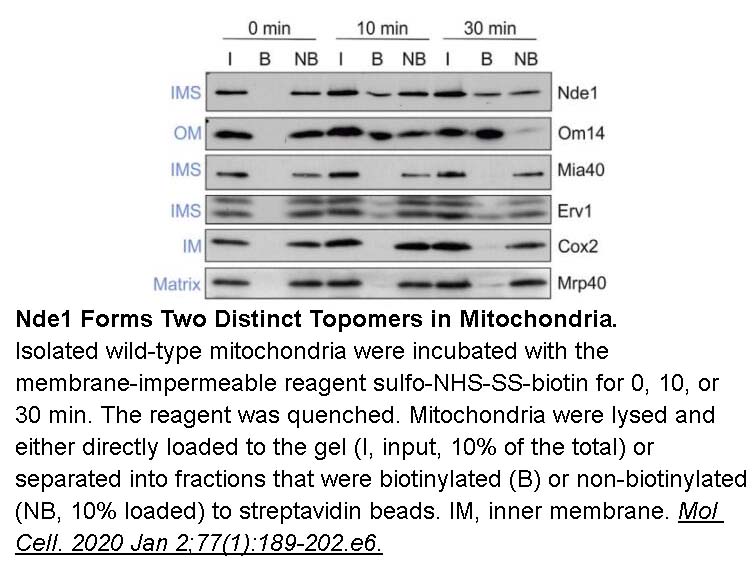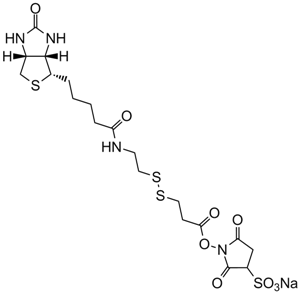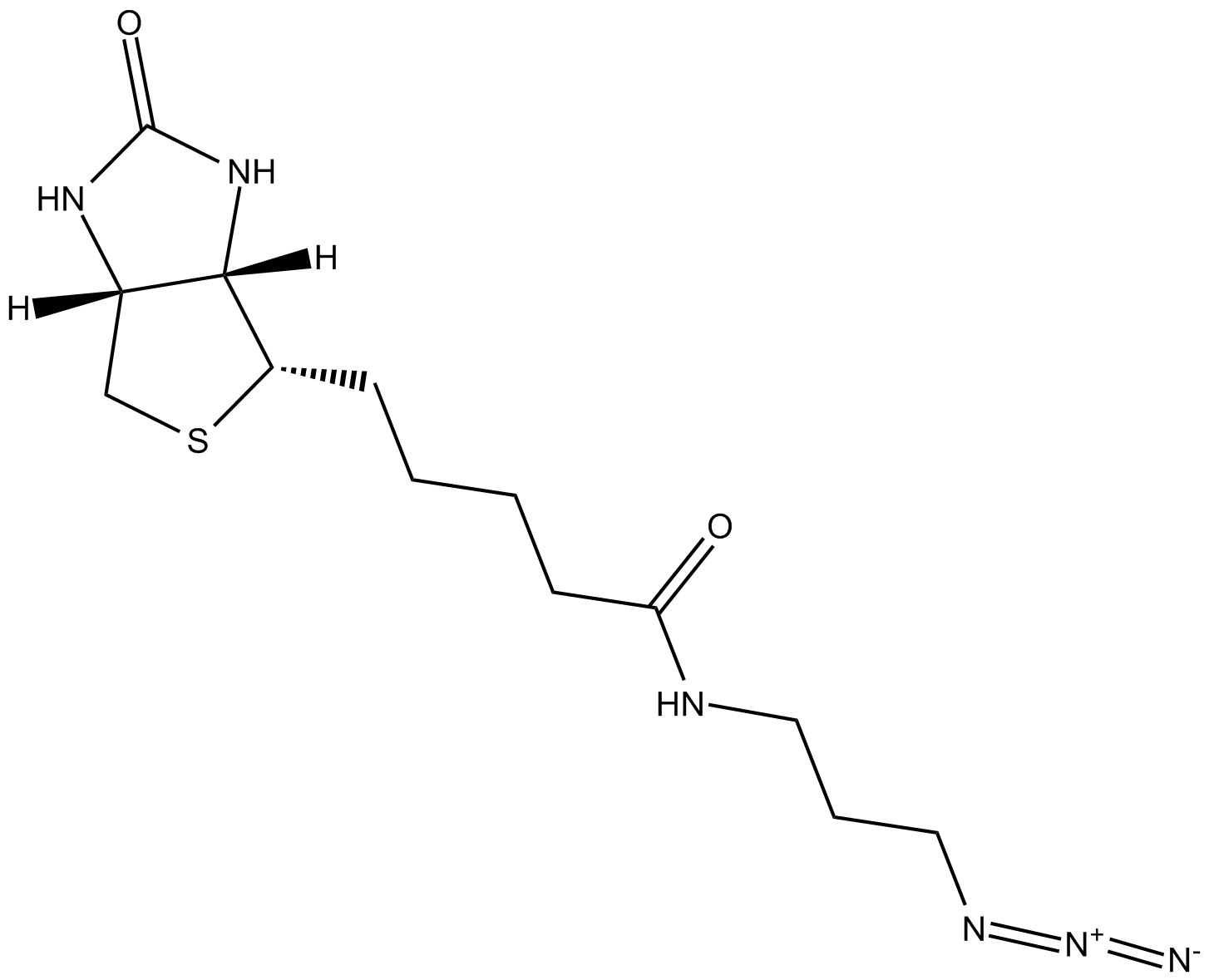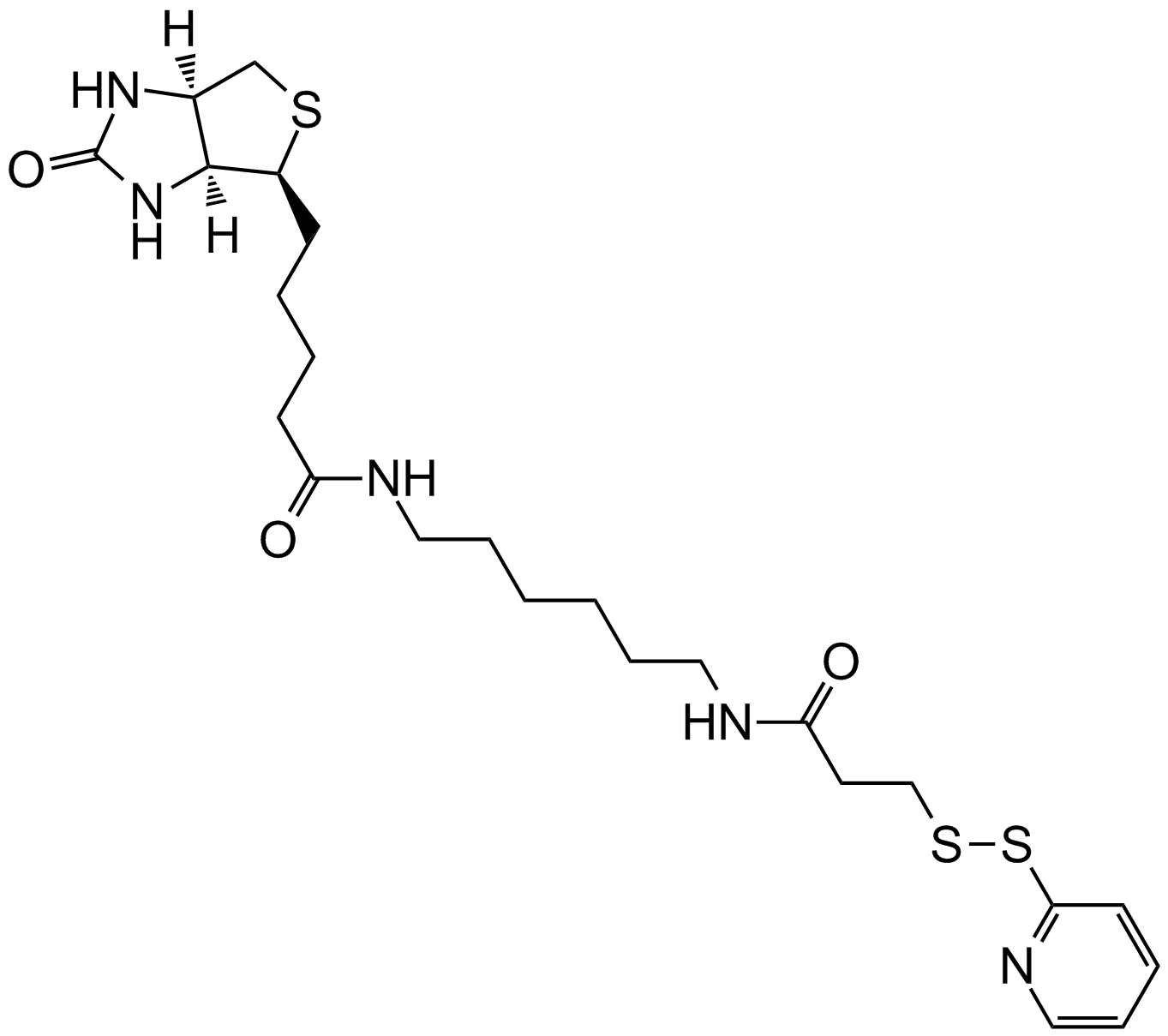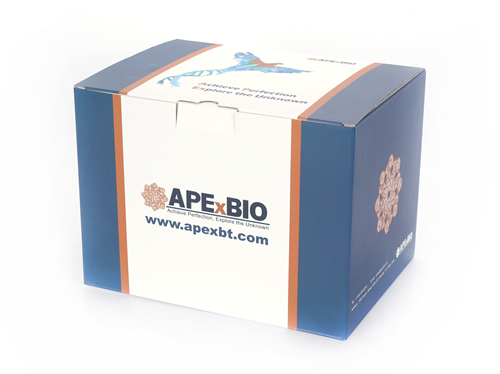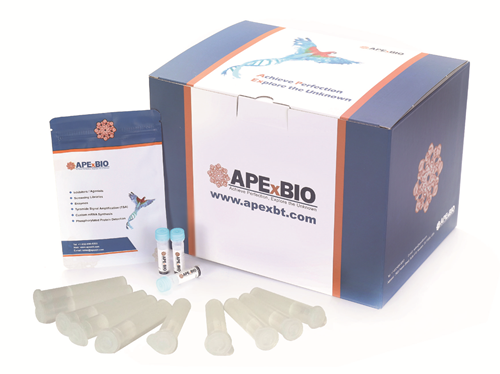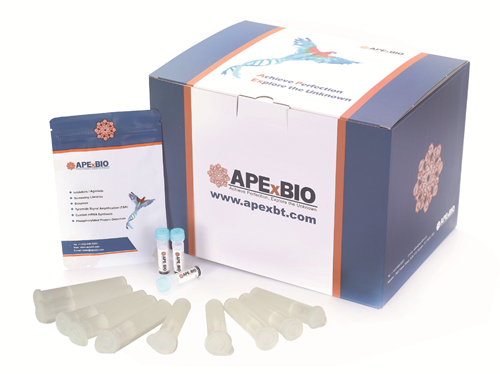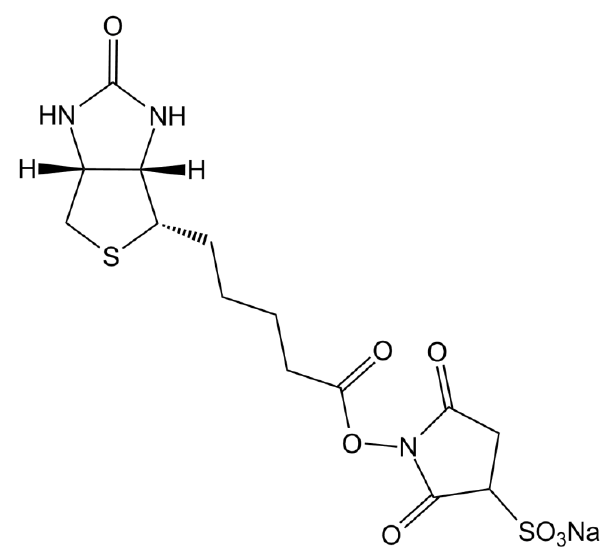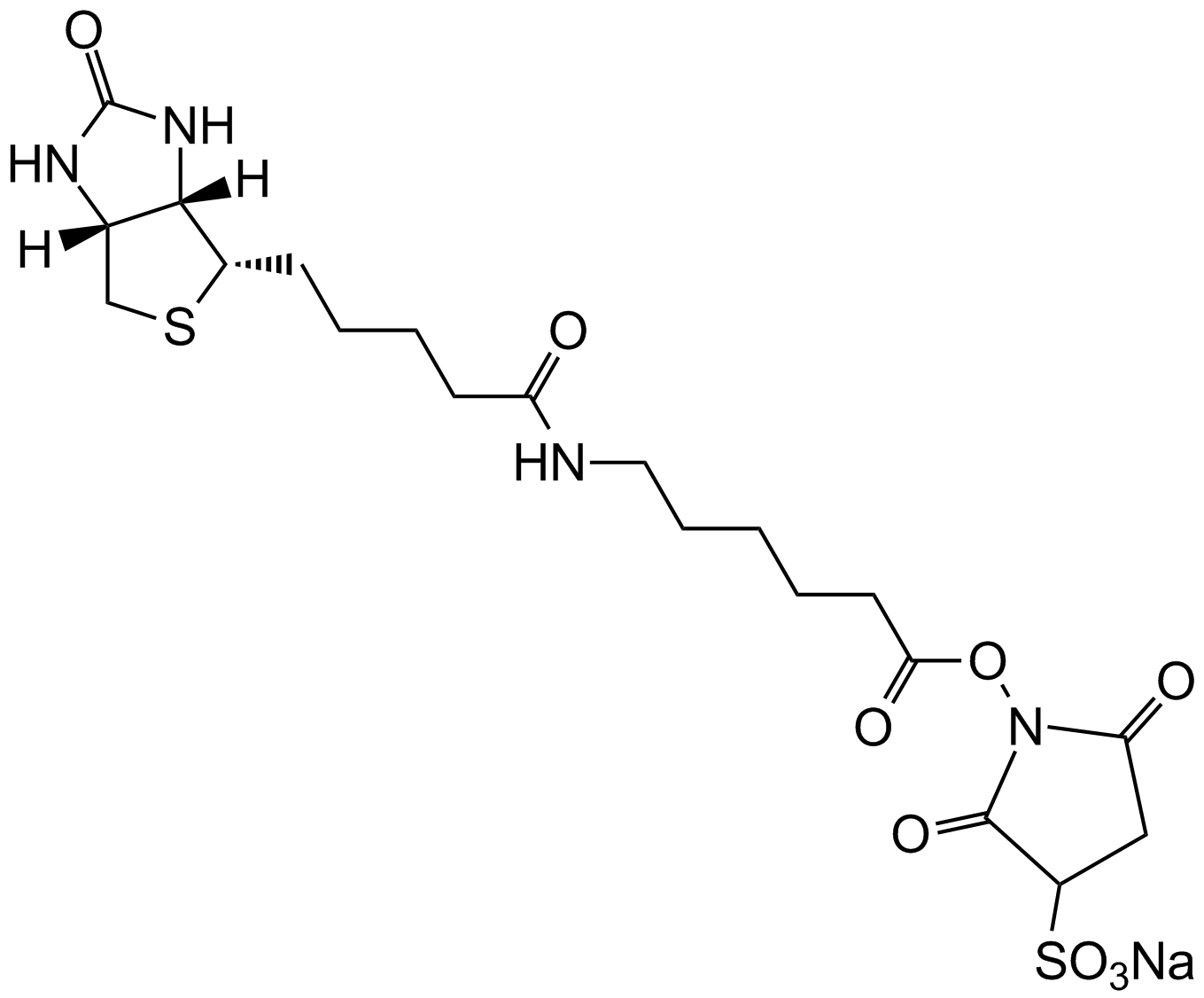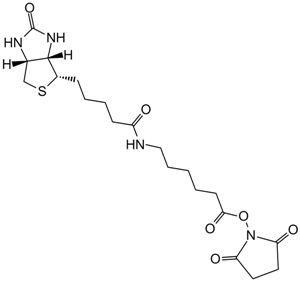Sulfo-NHS-SS-Biotin
Sulfo-NHS-SS-Biotin is an amine-reactive biotinylation reagent designed for labeling molecules containing primary amines. This compound possesses a negatively charged sulfonate group, imparting enhanced aqueous solubility and enabling its direct use in aqueous reaction systems without organic solvents. Its sulfo-NHS ester is unstable in solution, necessitating fresh preparation and immediate use to avoid hydrolysis. Post-conjugation, it forms stable complexes with amine targets, enabling purification/detection via avidin/streptavidin affinity chromatography. It is widely used in biochemical research for protein labeling, affinity purification, and bioconjugation.
Reference
Bioconjugate Techniques , 2nd ed. By Greg T.Hermanson (Pierce Biotechnology, Thermo Fisher Scientific, Rockford, IL). Academic Press (an imprint of Elsevier): London, Amsterdam, Burlington, San Diego . 2008. ISBN 978-0-12-370501-3.
- 1. Ru Huan, Peigen Xu, et al. "Molecular mechanisms for the activation of human organic anion transporting polypeptide 1B3 by quercetin-3-O-α-L-arabinopyranosyl (1→ 2)-α-L-rhamnopyranoside." International Journal of Biological Macromolecules Volume 338, Part 2, January 2026, 149809. PMID: 41423104
- 2. Xu Fu, Ya-Juan Wang, KyungA Lee. "Improving Proteostasis of Trafficking-Deficient GABAA Receptor Variants by Activating IRE1." ACS Chem Neurosci. 2025 Nov 2. PMID: 41178115
- 3. De Xie, Qiuyang Zheng, Jiaming Lv. "Uric Acid Functions as an Endogenous Modulator of Microglial Function and Amyloid Clearance in Alzheimer's Disease." Adv Sci (Weinh) . 2025 Oct 6:e10270. PMID: 41051385
- 4. Shuizhen Shi, Fan Xia, et al. "Epac1 deletion attenuates Müller glial pathological activation and mitigates retinal neurodegeneration in ischemia-induced retinopathy." J Adv Res. 2025 Sep 19:S2090-1232(25)00735-0. PMID: 40976555
- 5. Jonathan Berthiaume, Audrey-Ann Dumont, et al. "ArfGAP with Dual Pleckstrin Homology Domains 2 Promotes Hypertrophy of Cultured Neonatal Cardiomyocytes." Int J Mol Sci. 2025 Aug 6;26(15):7588. PMID: 40806715
- 6. Yandan Ren, Ziyan Wang, et al. "Deficiency of Rab26 causes behavioral defects in mice through impaired trafficking of SERT." iScience. 2025 Jun 18;28(7):112931. PMID: 40687824
- 7. Gabriel M Kline, Lisa Boinon, et al. "Phenylhydrazone-based Endoplasmic Reticulum Proteostasis Regulator Compounds with Enhanced Biological Activity." bioRxiv. 2025 Apr 5:2025.04.04.646800. PMID: 40236048
- 8. Na Li, Yiqing Wei, et al. "Modulation of the human GlyT1 by clinical drugs and cholesterol." Nature Communications volume 16, Article number: 2412 (2025) PMID: 40069141
- 9. Xinyi Huang, Zhifang Li, et al. "Vimentin intermediate filaments coordinate actin stress fibers and podosomes to determine the extracellular matrix degradation by macrophages." Dev Cell. 2025 Feb 7:S1534-5807(25)00036-X. PMID: 39952241
- 10. Ran Tao, Alan D. Robertson, et al. "Palmitoylation and regulation of potassium-dependent sodium/calcium exchangers (NCKX)." Biosci Rep. 2025 Jan 30;45(1):1-11. PMID: 39693635
- 11. Marnie P. Williams, Ya-Juan Wang, et al. "GABRA1 frameshift variants impair GABAA receptor proteostasis." bioRxiv. January 08, 2025. PMID: 39651292
- 12. Shuzhi Cui, Wei Gao, et al. "CDC42 supports HBV entry by NTCP translocation to the plasma membrane and macropinocytosis." EMBO Rep. 2025 Sep 15
- 13. Benson M. George, Maria Eleftheriou, et al. "Treatment of acute myeloid leukemia models by targeting a cell surface RNA - binding protein." Nat Biotechnol (2025)
- 14. Tianyi Ji, Xiangying Li, et al. "N-Glycosylation Modification of Fzd4 Is Essential for the Fzd4-Wnt-β-Catenin Signalling Axis." Journal of Cellular and Molecular Medicine Volume29, Issue7 April 2025 e70539
- 15. Taylor M. Benske, Marnie P. Williams, et al. "A GluN2B disease-associated variant promotes degradation of NMDA receptors via autophagy." bioRxiv. January 13, 2025
- 16. Ya-Juan Wang, Hailey Seibert, et al. "Pharmacological chaperones restore proteostasis of epilepsy-associated GABA." Pharmacol Res. 2024 Oct:208:107356. PMID: 39216838
- 17. Neuza Domingues , Steve Catarino, et al. "Connexin43 promotes exocytosis of damaged lysosomes through actin remodelling." EMBO J. 2024 Jul 23. PMID: 39044100
- 18. Fang Ye, Zhikang Yuan, et al. "Endocytic activation and exosomal secretion of matriptase stimulate the second wave of EGF signaling to promote skin and breast cancer invasion." Cell Rep. 2024 Apr 23;43(4):114002. PMID: 38547126
- 19. Tingting Wu, Lulu Wang, et al. "Regulatory T cell-derived exosome mediated macrophages polarization for osteogenic differentiation in fracture repair." J Control Release. 2024 May:369:266-282. PMID: 38508525
- 20. Guoli Song, et al. "SELENOK-dependent CD36 palmitoylation regulates microglial functions and Aβ phagocytosis." Redox Biol. 2024 Apr:70:103064. PMID: 38320455
- 21. Weixiang Bian, Hua Jiang, et al. "A spatially defined human Notch receptor interaction network reveals Notch intracellular storage and Ataxin-2-mediated fast recycling." Cell Rep. 2023 Jul 25;42(7):112819. PMID: 37454291
- 22. Jian Chen, Shizhen Qiu, et al. "Tuning charge density of chimeric antigen receptor optimizes tonic signaling and CAR-T cell fitness." Cell Res. 2023 May;33(5):341-354. PMID: 36882513
- 23. Asma B Salek, Emily T Claeboe, et al. "Spinophilin dependent regulation of GluN2B‐containing NMDAR‐dependent calcium influx, GluN2B surface expression, and cleaved caspase expression." Synapse 2023 Feb 04. PMID: 36738175
- 24. Jonathan Perr, Andreas Langen, et al. "RNA binding proteins and glycoRNAs form domains on the cell surface for cell penetrating peptide entry." bioRvix. September 05, 2023
- 25. Shaoqin Zheng, Jiahui Lin, et al. "Aberrant Cholesterol Metabolism and Wnt/β‐Catenin Signaling Coalesce via Frizzled5 in Supporting Cancer Growth." Adv Sci (Weinh). 2022 Oct;9(28):e2200750. PMID: 35975457
- 26. Angela L Whittsette, Ya-Juan Wang, et al. "The Endoplasmic Reticulum Membrane Complex Promotes Trafficking And Function Of GABAA Receptors." iScience. 2022 Jul 13;25(8):104754. PMID: 35938049
- 27. Meng Wang, Edmund Cotter, et al. "Pharmacological activation of ATF6 remodels the proteostasis network to rescue pathogenic GABAA receptors." Cell Biosci. 2022 Apr 27;12(1):48. PMID: 35477478
- 28. Neuza Domingues, Steve Catarino, et al. "Cx43 promotes exocytosis of damaged lysosomes through actin remodelling." Research Square. December 21st, 2022
- 29. Zheng Niu, YiLing Zhang, et al. "Decreased NHE3 activity in intestinal epithelial cells in TGEV and PEDV-induced piglet diarrhea." Vet Microbiol. 2021 Dec;263:109263. PMID: 34749283
- 30. Jobe L. Ritchie, Jennifer L. Walters, et al. "Basolateral amygdala corticotropin-releasing factor receptor type 1 regulates context-cocaine memory strength during reconsolidation in a sex-dependent manner." Neuropharmacology. 2021 Dec 1;200:108819. PMID: 34610289
- 31. Zhenhui Song, Tao Yan, et al. "Reduced activity of intestinal surface Na+/H+ exchanger NHE3 is a key factor for induction of diarrhea after PEDV infection in neonatal piglets." Virology. 2021 Nov;563:64-73. PMID: 34464882
- 32. Yang Y, Yu Q, et al. "Decreased NHE3 activity and trafficking in TGEV-infected IPEC-J2 cells via the SGLT1-mediated P38 MAPK/AKt2 pathway." Virus Res. 2020;280:197901. PMID: 32070687
- 33. Saladi S, Boos F, et al. "The NADH Dehydrogenase Nde1 Executes Cell Death after Integrating Signals from Metabolism and Proteostasis on the Mitochondrial Surface." Mol Cell. 2019 Oct 18. pii: S1097-2765(19)30732-4. PMID: 31668496
- 34. Carrington S, Hernandez C, et al. "G protein-coupled receptors differentially regulate glycosylation and activity of the inwardly rectifying potassium channel Kir7.1." J Biol Chem. 2018 Sep 26. pii: jbc.RA118.003238. PMID: 30257863
- 35. Brasher MI, Martynowicz DM, et al. "Interaction of Munc18c and Syntaxin4 facilitates invadopodium formation and extracellular matrix invasion of tumour cells." J Biol Chem. 2017 Aug 10. pii: jbc.M117.807438. PMID: 28798239
• Protein labeling—biotinylate antibodies to facilitate immobilization, purification or detection
• Cell surface labeling—do not penetrate the plasma membrane, biotinylates only surface proteins of whole cells
• Amine-reactive—reacts with primary amines (-NH2), such as lysine side-chains, or the N-terminal-amine
• Cleavable—disulfide bond in spacer arm allows the biotin label to be removed using reducing agents such as DTT
• Soluble—charged sulfo-NHS group increases reagent water solubility compared to ordinary NHS-ester compounds
• Medium length—spacer arm is 24.3 angstroms; it consists of the native biotin valeric acid group extended by a 7-atom chain
| Storage | Store at -20°CThe product is not stable in solution, please dissolve it immediately before use. |
| M.Wt | 606.7 |
| Cas No. | 325143-98-4 |
| Formula | C19H27N4NaO9S4 |
| Synonyms | Biotin disulfide N-hydroxysulfosuccinimide ester |
| Solubility | ≥30.33 mg/mL in DMSO; <2.68 mg/mL in EtOH; <2.74 mg/mL in H2O |
| Chemical Name | sodium;1-[3-[2-[5-[(3aS,4S,6aR)-2-oxo-1,3,3a,4,6,6a-hexahydrothieno[3,4-d]imidazol-4-yl]pentanoylamino]ethyldisulfanyl]propanoyloxy]-2,5-dioxopyrrolidine-3-sulfonate |
| SDF | Download SDF |
| Canonical SMILES | C1C(C(=O)N(C1=O)OC(=O)CCSSCCNC(=O)CCCCC2C3C(CS2)NC(=O)N3)S(=O)(=O)[O-].[Na+] |
| Shipping Condition | Small Molecules with Blue Ice, Modified Nucleotides with Dry Ice. |
| General tips | We do not recommend long-term storage for the solution, please use it up soon. |
| Biotinylation method [1]: | |
|
Sample |
468/EV cells and 468/uPAR cells. |
|
Preparation method |
Soluble in water, DMSO or DMF. |
|
Reaction Conditions |
1 mg/ml, 15minutes on ice |
|
Applications |
Cells in monolayer culture (1.5 × 106) were washed three times with ice-cold PBS and then treated with sulfo-NHS-SS-biotin (1mg/mL) for 15 minutes on ice. Biotinylation reactions were terminated with 100 mmol/L glycine in PBS. After washing with PBS, cell extracts were prepared in radioimmunoprecipitation assay (RIPA) buffer (20 mmol/L sodium phosphate, 150 mmol/L NaCl (pH 7.4), 1% NP40, 0.1% SDS, and 0.5% deoxycholic acid) with protease inhibitor cocktail. Biotinylated membrane proteins were precipitated with streptavidin-sepharose. Proteins were eluted with SDS sample buffer, resolved by SDS-PAGE, electrotransferred to polyvinylidene difluoride (PVDF) membranes, and probed with primary antibodies. |
|
References: [1]. Minji Jo, Boryana M. Eastman, Drue L. Webb, et al. Cell Signaling by Urokinase-type Plasminogen Activator Receptor Induces Stem Cell-like Properties in Breast Cancer cells . Cancer Res, 2010;70:8948-8958 |
|
| Description | Sulfo-NHS-SS-Biotin is a water-soluble, NHS-ester biotinylation reagent | |||||
| Targets | ||||||
| IC50 | ||||||
Quality Control & MSDS
- View current batch:
Chemical structure
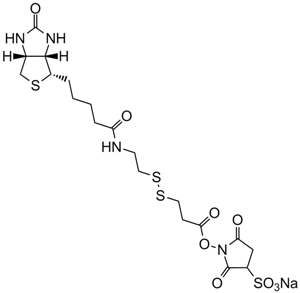
Related Biological Data
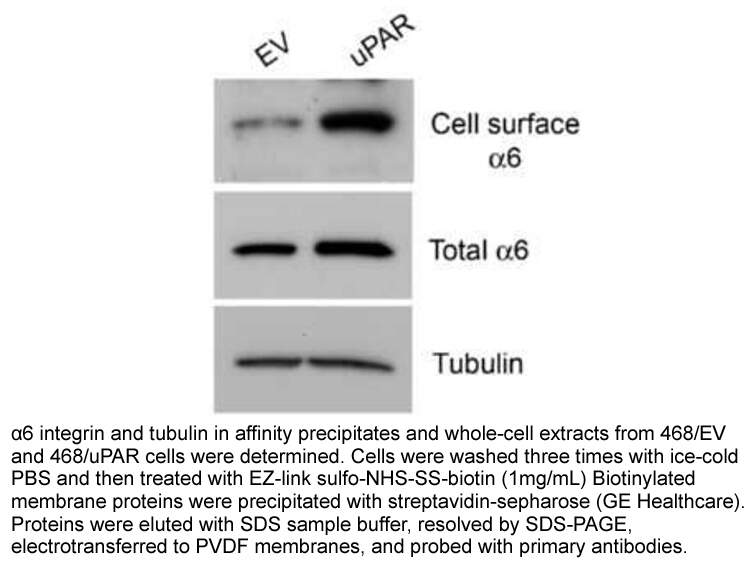
Related Biological Data
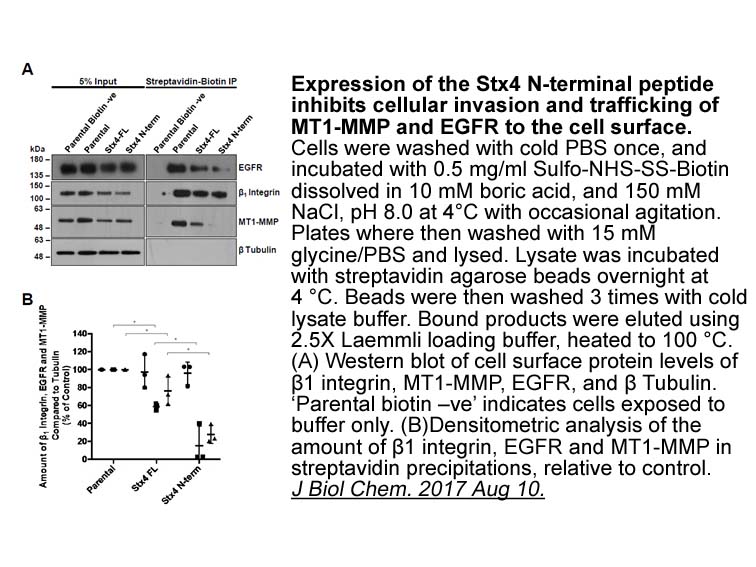
Related Biological Data
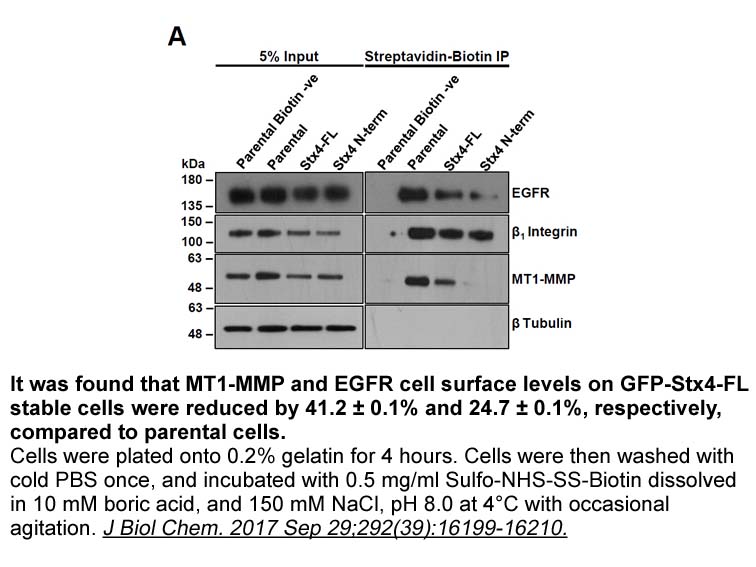
Related Biological Data
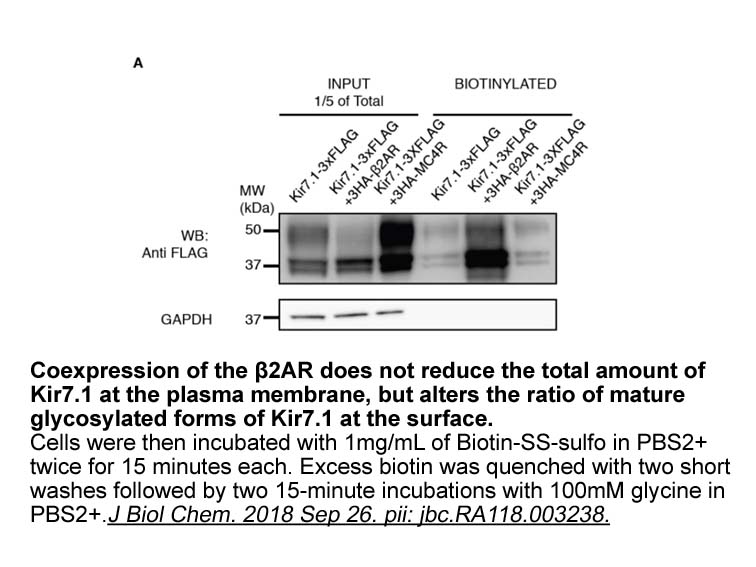
Related Biological Data
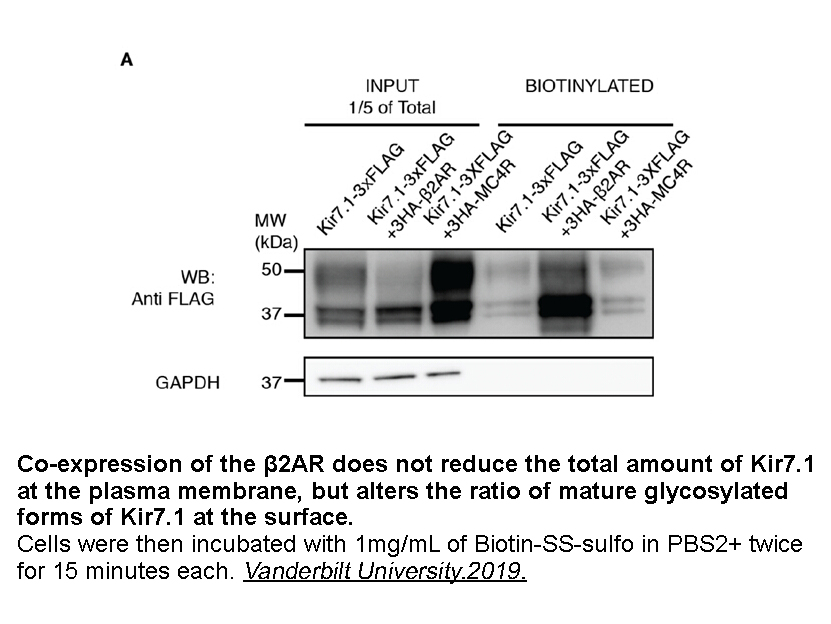
Related Biological Data
